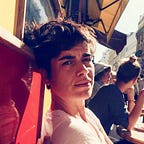“In Omar Imam’s work, there are no solutions. His pictures, different in composition as well as intention, directly question the conventions of “humanitarian photography.” He often sets his pictures in front of the ubiquitous white tents that appear in photographs distributed by the NGOs and U.N. agencies that run the camps in northern Lebanon in which he works. In his photographs, the tents do not represent shelter provided by the global community; rather, they are curtains in front of which is revealed the theater of life.”
– Eric Gottesman, Omar Imam’s mentor, on the portrait series, “Love, Live, Refugee”
 To me, the first word that comes to mind when looking at the portraits is freedom. Together with his subjects, fellow Syrians in Lebanon’s refugee camps, he created a series that transcends the limitations of photojournalistic narratives — and creates work that feels dreamlike. There is a lightness, humor, and dignity in the scenes that is hard to come by in mainstream coverage of refugees. The interplay of light and dark, humor and tragedy connects the viewer to the subjects depicted in these photographs in ways that are surprising and deeply human.
To me, the first word that comes to mind when looking at the portraits is freedom. Together with his subjects, fellow Syrians in Lebanon’s refugee camps, he created a series that transcends the limitations of photojournalistic narratives — and creates work that feels dreamlike. There is a lightness, humor, and dignity in the scenes that is hard to come by in mainstream coverage of refugees. The interplay of light and dark, humor and tragedy connects the viewer to the subjects depicted in these photographs in ways that are surprising and deeply human.
Imam himself had to flee Damascus with is family in 2012 and, although his parents regularly travel to Syria, he hasn’t been back.
Imam’s representation of the dreams and nightmares experienced by refugees echoes the work of Tim Hetherington in The Sleeping Soldier. Hetherington, who died while covering the Libyan uprising in 2011, had an early intuition about the importance of reinventing photographic storytelling. Following his death, The Tim Hetherington Visionary Award was created to nurture new voices and it’s only fitting that Imam became a recipient in 2017.
I recently met up with Imam in Amsterdam, Holland at the Rijksakademie where he is an artist-in-residence. It was dark and windy outside, and the imposing building of the academy was deserted, so I was relieved to be greeted by Imam’s friendly smile and warm demeanor.
Here are several of the photographs he created in the refugee camps in Lebanon’s Bekaa Valley, followed by an extract of our conversation.
Why did you choose to volunteer at the refugee camp of the Bekaa Valley in Lebanon? What was your role there?
I started working as a volunteer in Syria in 2012 with internally displaced populations. I wanted to continue [working with refugees] when I had to flee the country to Lebanon. I was helping with logistics, collecting money to buy food for refugees. I prefer to work individually on a small scale because lots of money got lost. But I had contacts with some NGOs and this is how they introduced me to the camps.
How is the photographic representation of refugees evolving?
As Syrians, we uploaded millions of photos and videos in the past 6 years, but they are the same five or six images: the fighter, the politician, the bloody boy, the refugee in the mud and people on rubber boats… We’re endlessly repeating the same images. These images give the impression that refugees have no education, no money, anonymous abstract backgrounds. You can’t tell whether they eat on trees or tables. Once I met a friend of a friend who was surprised that I had a professional camera. She asked, “Oh you are a refugee and you have this camera?” And I said, “Yes, I have a Mark 3 and also other cameras as well.”
There is a will to change [these] stereotypes. Institutions and organizations that usually take the lead in photojournalism and documentary photography feel the need for this. I was happy to break that pattern and to collaborate with refugees to come up with a different narrative.
How did you come up with the idea of staging dreams?
I was looking for something not documentary, trying to be more brave and confronting. People shared their stories, their dreams, their personalities. I wanted alternative images to reach an alternative outcome with the audience. No repetition, like when everyone knows [his or her] part. I wanted to shake this.
How do you think being photographed affects people we usually see in the news, victims of war or natural disaster, or refugees?
I was never photographed by foreign photographers as a refugee because I never stayed in a refugee camp. I drove from the house I rented in Beirut to the camps in the Bekaa Valley, two hours away. But I know how refugees feel exactly and I understand why they don’t like being photographed. Syrians are suspicious of photography in general. And as victims or refugees, it’s always hard to be on the weak side. On the other hand, they do it because they know attention will bring more aid. In Lebanon, most of the aid relief went to the Bekaa Valley because it was easy to access for the press and NGOs, while the eastern side was not. People there lived in a worse situation compared to those in the refugee camp. So the press coverage counts and people know that it counts and that’s why they accept to do it.
How do you see your role differing from the role of the “foreign press?”
I was concerned that stereotypical images of refugees work in a loop, with refugees themselves giving the press what is expected from them. The foreign photographers come with their blonde hair and good cameras and show empathy, while the other side shows victimization. It happened to me when I went to the refugee camps. On the first visit, people only wanted to show me how unfair their circumstances were, but when I told them I wasn’t looking for another story about victimization, they understood. People recognized and enjoyed creating images about dignity, about inspiration, while being realistic and not ignoring the difficulty of their circumstances. I hope I managed to show both.
What would your own self-portrait look like in the Love, Live, Refugee series?
I’ve never thought of that. I guess it would be very similar to Kawthar’s portrait, the “Dragon’s Bride” who wants to burn down her tent. It’s because we’ve experienced similar situations. We both survived being tortured at the hands of a group of people. Unlike most of the other subjects in the project, both she and I experienced trauma alone; it didn’t involve the rest of our families, thankfully.
What projects are you working on now?
I’m working to complete my projects about Syrians in Europe: Syrialism. And in 2019 I will be starting on a new fictional documentary about how the Muslim community is seen in Dutch society. It’s a sensitive topic that people prefer to avoid. Sometimes you need to belong to two societies to represent them. I feel like an insider in both. But it won’t be as serious as I’m describing it right now. It will be fun!
